Analysis of Benchmarking and Target Costing in Management Accounting
VerifiedAdded on 2023/06/03
|9
|2496
|115
Essay
AI Summary
This essay explores the application of benchmarking and target costing techniques in management accounting, focusing on their usefulness for businesses. Benchmarking involves comparing business processes and performance against industry best practices, considering quality, time, and cost. Target costing is a proactive approach to determine the total lifecycle cost of a product to ensure desired profit and quality. The essay discusses the use of these techniques in companies like Starbucks, Microsoft, Toyota and Sony, outlining their benefits, problems, and ethical issues. Benchmarking helps companies like Starbucks and Microsoft gain a competitive edge by adopting innovative practices, while target costing assists Toyota and Sony in reducing costs during the product design and development phases. The analysis also addresses challenges and ethical considerations associated with these techniques, such as maintaining product quality and avoiding unethical decisions driven by cost reduction goals. Ultimately, the essay concludes that benchmarking and target costing are valuable tools for minimizing operational risks and promoting long-term business growth.
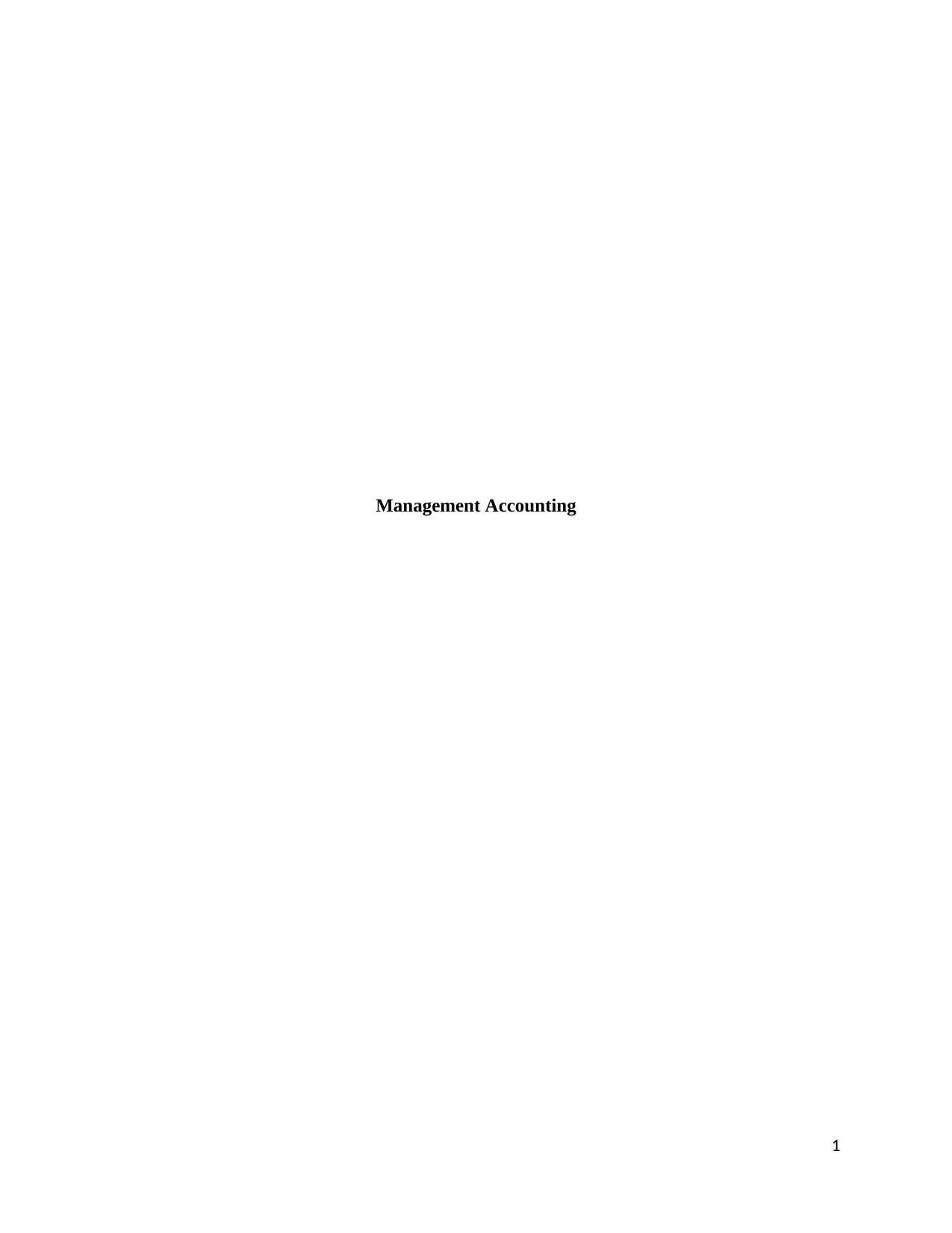
Management Accounting
1
1
Paraphrase This Document
Need a fresh take? Get an instant paraphrase of this document with our AI Paraphraser
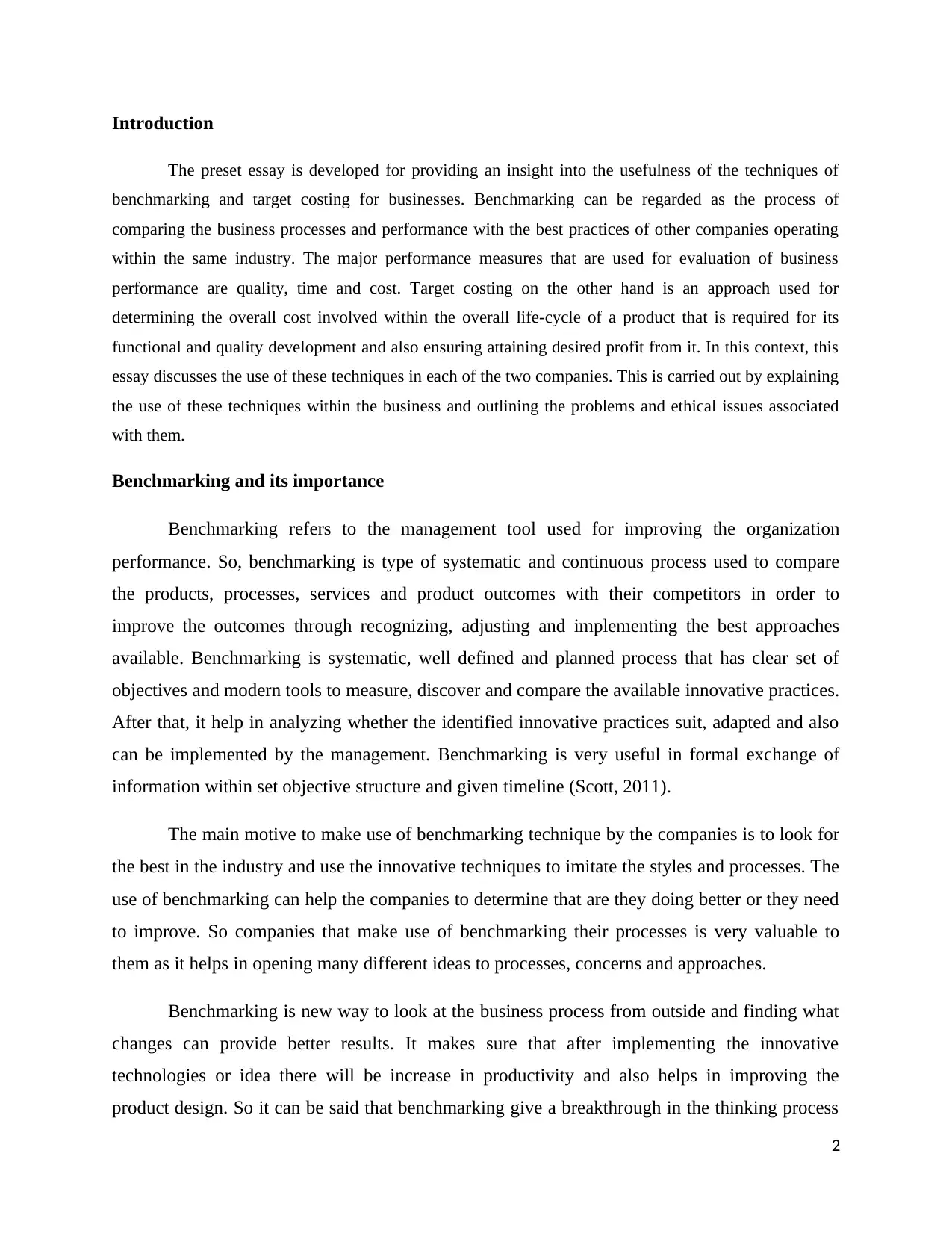
Introduction
The preset essay is developed for providing an insight into the usefulness of the techniques of
benchmarking and target costing for businesses. Benchmarking can be regarded as the process of
comparing the business processes and performance with the best practices of other companies operating
within the same industry. The major performance measures that are used for evaluation of business
performance are quality, time and cost. Target costing on the other hand is an approach used for
determining the overall cost involved within the overall life-cycle of a product that is required for its
functional and quality development and also ensuring attaining desired profit from it. In this context, this
essay discusses the use of these techniques in each of the two companies. This is carried out by explaining
the use of these techniques within the business and outlining the problems and ethical issues associated
with them.
Benchmarking and its importance
Benchmarking refers to the management tool used for improving the organization
performance. So, benchmarking is type of systematic and continuous process used to compare
the products, processes, services and product outcomes with their competitors in order to
improve the outcomes through recognizing, adjusting and implementing the best approaches
available. Benchmarking is systematic, well defined and planned process that has clear set of
objectives and modern tools to measure, discover and compare the available innovative practices.
After that, it help in analyzing whether the identified innovative practices suit, adapted and also
can be implemented by the management. Benchmarking is very useful in formal exchange of
information within set objective structure and given timeline (Scott, 2011).
The main motive to make use of benchmarking technique by the companies is to look for
the best in the industry and use the innovative techniques to imitate the styles and processes. The
use of benchmarking can help the companies to determine that are they doing better or they need
to improve. So companies that make use of benchmarking their processes is very valuable to
them as it helps in opening many different ideas to processes, concerns and approaches.
Benchmarking is new way to look at the business process from outside and finding what
changes can provide better results. It makes sure that after implementing the innovative
technologies or idea there will be increase in productivity and also helps in improving the
product design. So it can be said that benchmarking give a breakthrough in the thinking process
2
The preset essay is developed for providing an insight into the usefulness of the techniques of
benchmarking and target costing for businesses. Benchmarking can be regarded as the process of
comparing the business processes and performance with the best practices of other companies operating
within the same industry. The major performance measures that are used for evaluation of business
performance are quality, time and cost. Target costing on the other hand is an approach used for
determining the overall cost involved within the overall life-cycle of a product that is required for its
functional and quality development and also ensuring attaining desired profit from it. In this context, this
essay discusses the use of these techniques in each of the two companies. This is carried out by explaining
the use of these techniques within the business and outlining the problems and ethical issues associated
with them.
Benchmarking and its importance
Benchmarking refers to the management tool used for improving the organization
performance. So, benchmarking is type of systematic and continuous process used to compare
the products, processes, services and product outcomes with their competitors in order to
improve the outcomes through recognizing, adjusting and implementing the best approaches
available. Benchmarking is systematic, well defined and planned process that has clear set of
objectives and modern tools to measure, discover and compare the available innovative practices.
After that, it help in analyzing whether the identified innovative practices suit, adapted and also
can be implemented by the management. Benchmarking is very useful in formal exchange of
information within set objective structure and given timeline (Scott, 2011).
The main motive to make use of benchmarking technique by the companies is to look for
the best in the industry and use the innovative techniques to imitate the styles and processes. The
use of benchmarking can help the companies to determine that are they doing better or they need
to improve. So companies that make use of benchmarking their processes is very valuable to
them as it helps in opening many different ideas to processes, concerns and approaches.
Benchmarking is new way to look at the business process from outside and finding what
changes can provide better results. It makes sure that after implementing the innovative
technologies or idea there will be increase in productivity and also helps in improving the
product design. So it can be said that benchmarking give a breakthrough in the thinking process
2
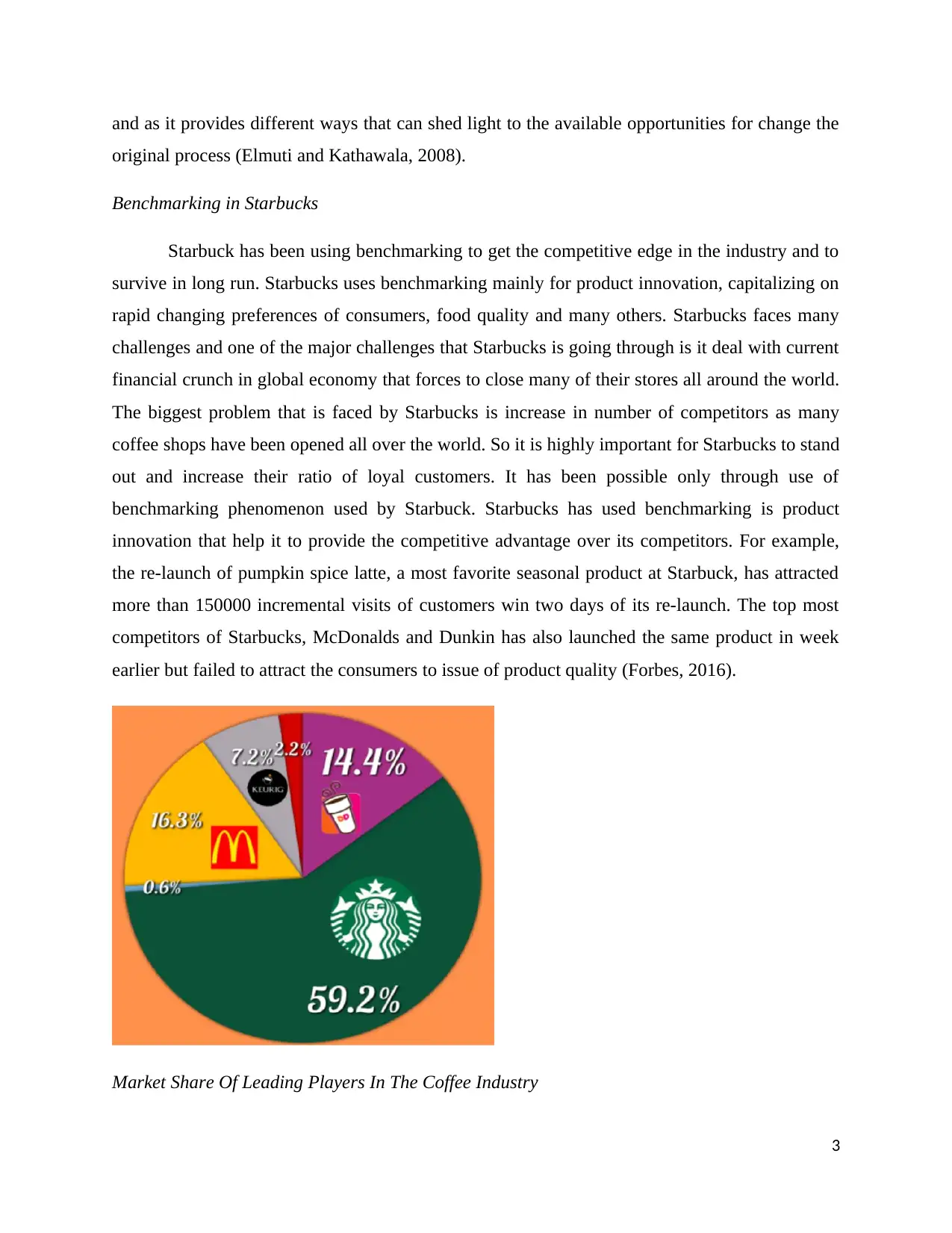
and as it provides different ways that can shed light to the available opportunities for change the
original process (Elmuti and Kathawala, 2008).
Benchmarking in Starbucks
Starbuck has been using benchmarking to get the competitive edge in the industry and to
survive in long run. Starbucks uses benchmarking mainly for product innovation, capitalizing on
rapid changing preferences of consumers, food quality and many others. Starbucks faces many
challenges and one of the major challenges that Starbucks is going through is it deal with current
financial crunch in global economy that forces to close many of their stores all around the world.
The biggest problem that is faced by Starbucks is increase in number of competitors as many
coffee shops have been opened all over the world. So it is highly important for Starbucks to stand
out and increase their ratio of loyal customers. It has been possible only through use of
benchmarking phenomenon used by Starbuck. Starbucks has used benchmarking is product
innovation that help it to provide the competitive advantage over its competitors. For example,
the re-launch of pumpkin spice latte, a most favorite seasonal product at Starbuck, has attracted
more than 150000 incremental visits of customers win two days of its re-launch. The top most
competitors of Starbucks, McDonalds and Dunkin has also launched the same product in week
earlier but failed to attract the consumers to issue of product quality (Forbes, 2016).
Market Share Of Leading Players In The Coffee Industry
3
original process (Elmuti and Kathawala, 2008).
Benchmarking in Starbucks
Starbuck has been using benchmarking to get the competitive edge in the industry and to
survive in long run. Starbucks uses benchmarking mainly for product innovation, capitalizing on
rapid changing preferences of consumers, food quality and many others. Starbucks faces many
challenges and one of the major challenges that Starbucks is going through is it deal with current
financial crunch in global economy that forces to close many of their stores all around the world.
The biggest problem that is faced by Starbucks is increase in number of competitors as many
coffee shops have been opened all over the world. So it is highly important for Starbucks to stand
out and increase their ratio of loyal customers. It has been possible only through use of
benchmarking phenomenon used by Starbuck. Starbucks has used benchmarking is product
innovation that help it to provide the competitive advantage over its competitors. For example,
the re-launch of pumpkin spice latte, a most favorite seasonal product at Starbuck, has attracted
more than 150000 incremental visits of customers win two days of its re-launch. The top most
competitors of Starbucks, McDonalds and Dunkin has also launched the same product in week
earlier but failed to attract the consumers to issue of product quality (Forbes, 2016).
Market Share Of Leading Players In The Coffee Industry
3
⊘ This is a preview!⊘
Do you want full access?
Subscribe today to unlock all pages.

Trusted by 1+ million students worldwide
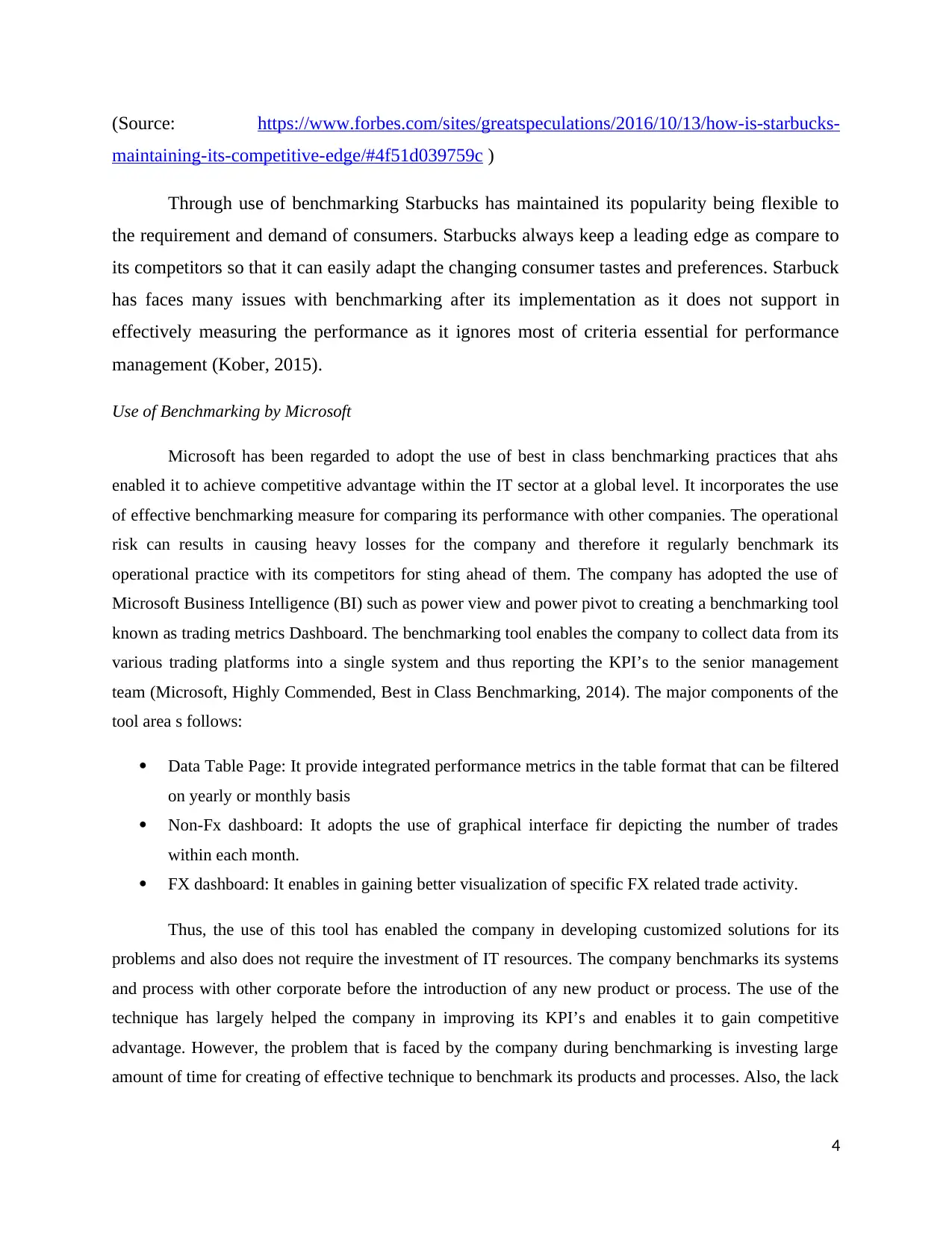
(Source: https://www.forbes.com/sites/greatspeculations/2016/10/13/how-is-starbucks-
maintaining-its-competitive-edge/#4f51d039759c )
Through use of benchmarking Starbucks has maintained its popularity being flexible to
the requirement and demand of consumers. Starbucks always keep a leading edge as compare to
its competitors so that it can easily adapt the changing consumer tastes and preferences. Starbuck
has faces many issues with benchmarking after its implementation as it does not support in
effectively measuring the performance as it ignores most of criteria essential for performance
management (Kober, 2015).
Use of Benchmarking by Microsoft
Microsoft has been regarded to adopt the use of best in class benchmarking practices that ahs
enabled it to achieve competitive advantage within the IT sector at a global level. It incorporates the use
of effective benchmarking measure for comparing its performance with other companies. The operational
risk can results in causing heavy losses for the company and therefore it regularly benchmark its
operational practice with its competitors for sting ahead of them. The company has adopted the use of
Microsoft Business Intelligence (BI) such as power view and power pivot to creating a benchmarking tool
known as trading metrics Dashboard. The benchmarking tool enables the company to collect data from its
various trading platforms into a single system and thus reporting the KPI’s to the senior management
team (Microsoft, Highly Commended, Best in Class Benchmarking, 2014). The major components of the
tool area s follows:
Data Table Page: It provide integrated performance metrics in the table format that can be filtered
on yearly or monthly basis
Non-Fx dashboard: It adopts the use of graphical interface fir depicting the number of trades
within each month.
FX dashboard: It enables in gaining better visualization of specific FX related trade activity.
Thus, the use of this tool has enabled the company in developing customized solutions for its
problems and also does not require the investment of IT resources. The company benchmarks its systems
and process with other corporate before the introduction of any new product or process. The use of the
technique has largely helped the company in improving its KPI’s and enables it to gain competitive
advantage. However, the problem that is faced by the company during benchmarking is investing large
amount of time for creating of effective technique to benchmark its products and processes. Also, the lack
4
maintaining-its-competitive-edge/#4f51d039759c )
Through use of benchmarking Starbucks has maintained its popularity being flexible to
the requirement and demand of consumers. Starbucks always keep a leading edge as compare to
its competitors so that it can easily adapt the changing consumer tastes and preferences. Starbuck
has faces many issues with benchmarking after its implementation as it does not support in
effectively measuring the performance as it ignores most of criteria essential for performance
management (Kober, 2015).
Use of Benchmarking by Microsoft
Microsoft has been regarded to adopt the use of best in class benchmarking practices that ahs
enabled it to achieve competitive advantage within the IT sector at a global level. It incorporates the use
of effective benchmarking measure for comparing its performance with other companies. The operational
risk can results in causing heavy losses for the company and therefore it regularly benchmark its
operational practice with its competitors for sting ahead of them. The company has adopted the use of
Microsoft Business Intelligence (BI) such as power view and power pivot to creating a benchmarking tool
known as trading metrics Dashboard. The benchmarking tool enables the company to collect data from its
various trading platforms into a single system and thus reporting the KPI’s to the senior management
team (Microsoft, Highly Commended, Best in Class Benchmarking, 2014). The major components of the
tool area s follows:
Data Table Page: It provide integrated performance metrics in the table format that can be filtered
on yearly or monthly basis
Non-Fx dashboard: It adopts the use of graphical interface fir depicting the number of trades
within each month.
FX dashboard: It enables in gaining better visualization of specific FX related trade activity.
Thus, the use of this tool has enabled the company in developing customized solutions for its
problems and also does not require the investment of IT resources. The company benchmarks its systems
and process with other corporate before the introduction of any new product or process. The use of the
technique has largely helped the company in improving its KPI’s and enables it to gain competitive
advantage. However, the problem that is faced by the company during benchmarking is investing large
amount of time for creating of effective technique to benchmark its products and processes. Also, the lack
4
Paraphrase This Document
Need a fresh take? Get an instant paraphrase of this document with our AI Paraphraser
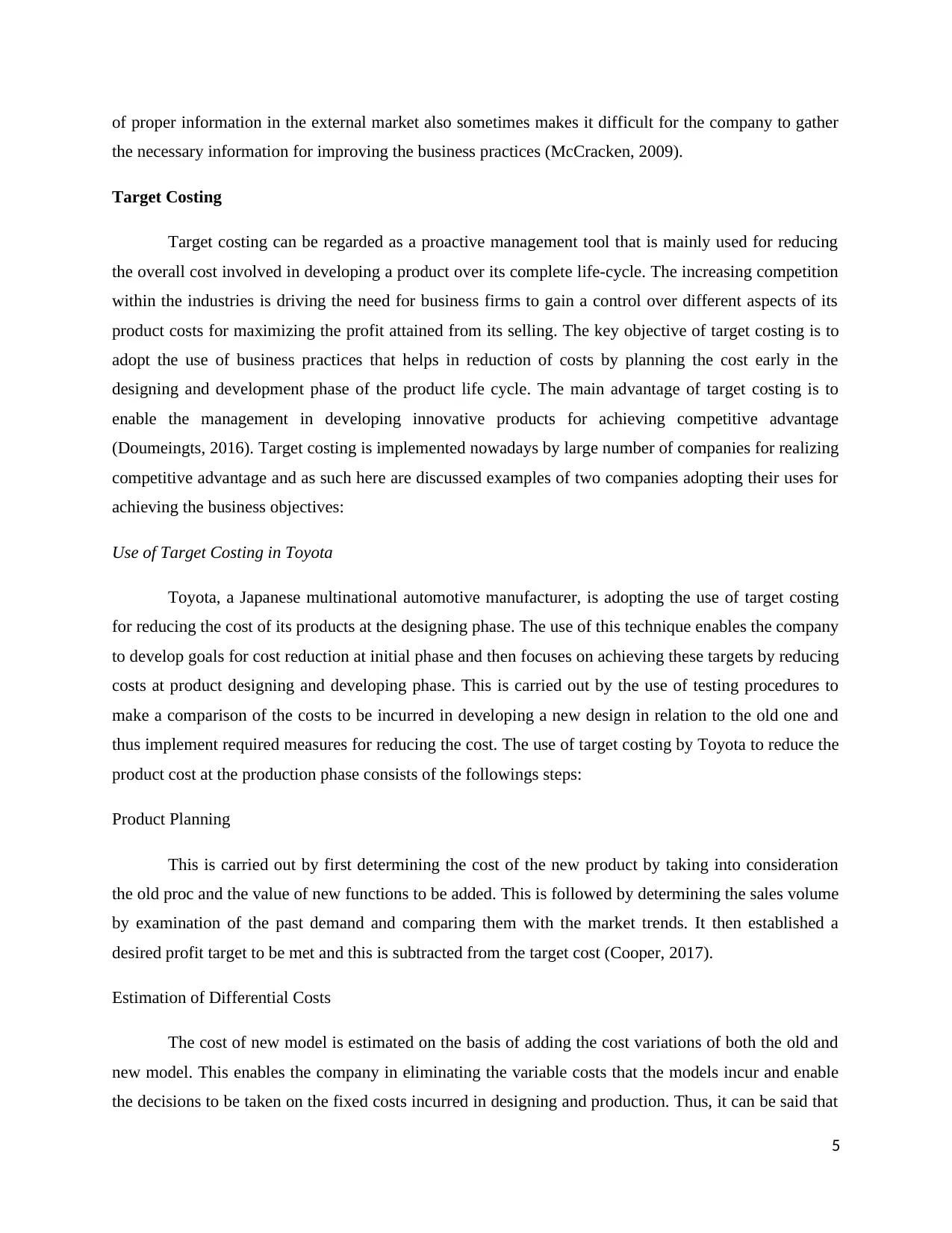
of proper information in the external market also sometimes makes it difficult for the company to gather
the necessary information for improving the business practices (McCracken, 2009).
Target Costing
Target costing can be regarded as a proactive management tool that is mainly used for reducing
the overall cost involved in developing a product over its complete life-cycle. The increasing competition
within the industries is driving the need for business firms to gain a control over different aspects of its
product costs for maximizing the profit attained from its selling. The key objective of target costing is to
adopt the use of business practices that helps in reduction of costs by planning the cost early in the
designing and development phase of the product life cycle. The main advantage of target costing is to
enable the management in developing innovative products for achieving competitive advantage
(Doumeingts, 2016). Target costing is implemented nowadays by large number of companies for realizing
competitive advantage and as such here are discussed examples of two companies adopting their uses for
achieving the business objectives:
Use of Target Costing in Toyota
Toyota, a Japanese multinational automotive manufacturer, is adopting the use of target costing
for reducing the cost of its products at the designing phase. The use of this technique enables the company
to develop goals for cost reduction at initial phase and then focuses on achieving these targets by reducing
costs at product designing and developing phase. This is carried out by the use of testing procedures to
make a comparison of the costs to be incurred in developing a new design in relation to the old one and
thus implement required measures for reducing the cost. The use of target costing by Toyota to reduce the
product cost at the production phase consists of the followings steps:
Product Planning
This is carried out by first determining the cost of the new product by taking into consideration
the old proc and the value of new functions to be added. This is followed by determining the sales volume
by examination of the past demand and comparing them with the market trends. It then established a
desired profit target to be met and this is subtracted from the target cost (Cooper, 2017).
Estimation of Differential Costs
The cost of new model is estimated on the basis of adding the cost variations of both the old and
new model. This enables the company in eliminating the variable costs that the models incur and enable
the decisions to be taken on the fixed costs incurred in designing and production. Thus, it can be said that
5
the necessary information for improving the business practices (McCracken, 2009).
Target Costing
Target costing can be regarded as a proactive management tool that is mainly used for reducing
the overall cost involved in developing a product over its complete life-cycle. The increasing competition
within the industries is driving the need for business firms to gain a control over different aspects of its
product costs for maximizing the profit attained from its selling. The key objective of target costing is to
adopt the use of business practices that helps in reduction of costs by planning the cost early in the
designing and development phase of the product life cycle. The main advantage of target costing is to
enable the management in developing innovative products for achieving competitive advantage
(Doumeingts, 2016). Target costing is implemented nowadays by large number of companies for realizing
competitive advantage and as such here are discussed examples of two companies adopting their uses for
achieving the business objectives:
Use of Target Costing in Toyota
Toyota, a Japanese multinational automotive manufacturer, is adopting the use of target costing
for reducing the cost of its products at the designing phase. The use of this technique enables the company
to develop goals for cost reduction at initial phase and then focuses on achieving these targets by reducing
costs at product designing and developing phase. This is carried out by the use of testing procedures to
make a comparison of the costs to be incurred in developing a new design in relation to the old one and
thus implement required measures for reducing the cost. The use of target costing by Toyota to reduce the
product cost at the production phase consists of the followings steps:
Product Planning
This is carried out by first determining the cost of the new product by taking into consideration
the old proc and the value of new functions to be added. This is followed by determining the sales volume
by examination of the past demand and comparing them with the market trends. It then established a
desired profit target to be met and this is subtracted from the target cost (Cooper, 2017).
Estimation of Differential Costs
The cost of new model is estimated on the basis of adding the cost variations of both the old and
new model. This enables the company in eliminating the variable costs that the models incur and enable
the decisions to be taken on the fixed costs incurred in designing and production. Thus, it can be said that
5
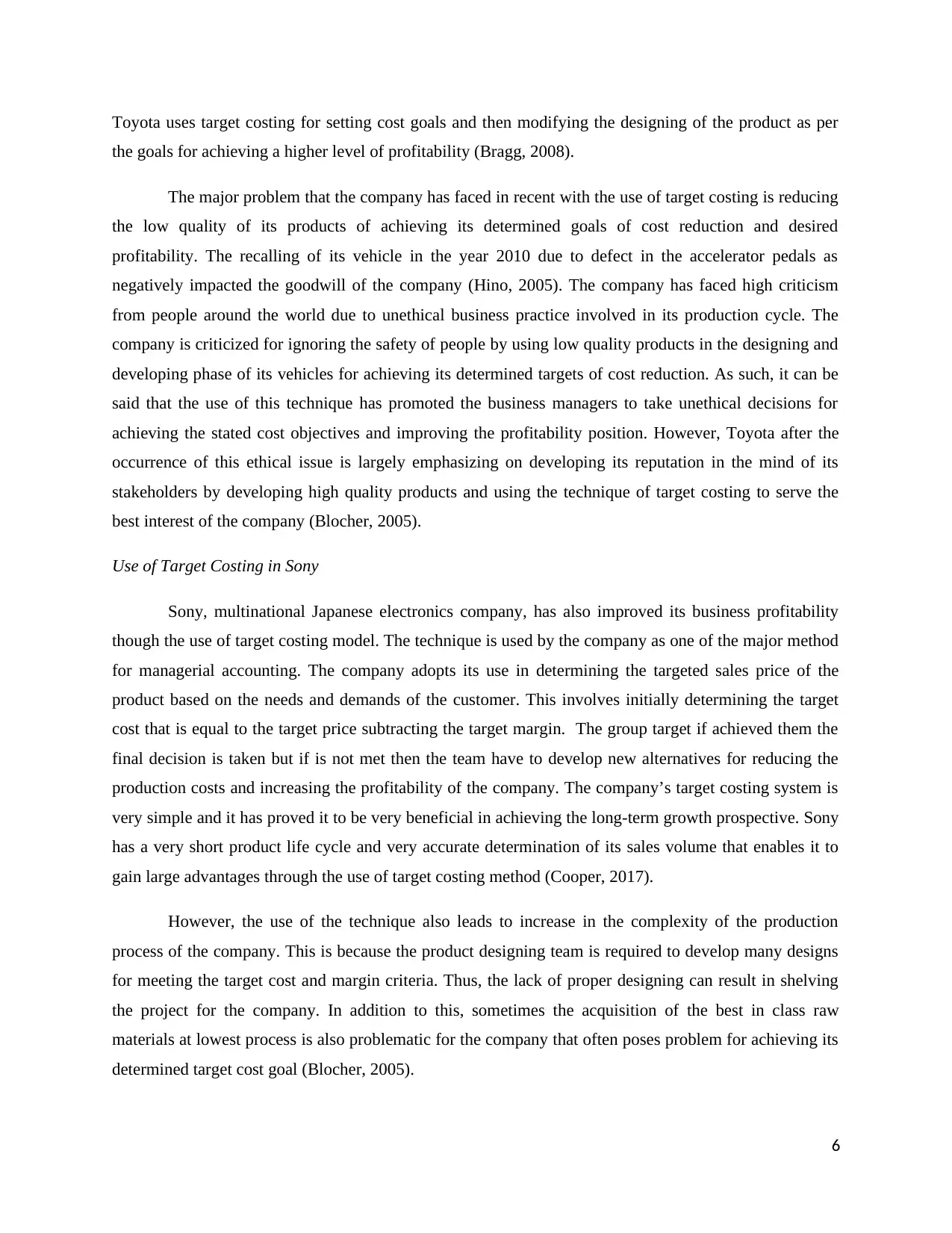
Toyota uses target costing for setting cost goals and then modifying the designing of the product as per
the goals for achieving a higher level of profitability (Bragg, 2008).
The major problem that the company has faced in recent with the use of target costing is reducing
the low quality of its products of achieving its determined goals of cost reduction and desired
profitability. The recalling of its vehicle in the year 2010 due to defect in the accelerator pedals as
negatively impacted the goodwill of the company (Hino, 2005). The company has faced high criticism
from people around the world due to unethical business practice involved in its production cycle. The
company is criticized for ignoring the safety of people by using low quality products in the designing and
developing phase of its vehicles for achieving its determined targets of cost reduction. As such, it can be
said that the use of this technique has promoted the business managers to take unethical decisions for
achieving the stated cost objectives and improving the profitability position. However, Toyota after the
occurrence of this ethical issue is largely emphasizing on developing its reputation in the mind of its
stakeholders by developing high quality products and using the technique of target costing to serve the
best interest of the company (Blocher, 2005).
Use of Target Costing in Sony
Sony, multinational Japanese electronics company, has also improved its business profitability
though the use of target costing model. The technique is used by the company as one of the major method
for managerial accounting. The company adopts its use in determining the targeted sales price of the
product based on the needs and demands of the customer. This involves initially determining the target
cost that is equal to the target price subtracting the target margin. The group target if achieved them the
final decision is taken but if is not met then the team have to develop new alternatives for reducing the
production costs and increasing the profitability of the company. The company’s target costing system is
very simple and it has proved it to be very beneficial in achieving the long-term growth prospective. Sony
has a very short product life cycle and very accurate determination of its sales volume that enables it to
gain large advantages through the use of target costing method (Cooper, 2017).
However, the use of the technique also leads to increase in the complexity of the production
process of the company. This is because the product designing team is required to develop many designs
for meeting the target cost and margin criteria. Thus, the lack of proper designing can result in shelving
the project for the company. In addition to this, sometimes the acquisition of the best in class raw
materials at lowest process is also problematic for the company that often poses problem for achieving its
determined target cost goal (Blocher, 2005).
6
the goals for achieving a higher level of profitability (Bragg, 2008).
The major problem that the company has faced in recent with the use of target costing is reducing
the low quality of its products of achieving its determined goals of cost reduction and desired
profitability. The recalling of its vehicle in the year 2010 due to defect in the accelerator pedals as
negatively impacted the goodwill of the company (Hino, 2005). The company has faced high criticism
from people around the world due to unethical business practice involved in its production cycle. The
company is criticized for ignoring the safety of people by using low quality products in the designing and
developing phase of its vehicles for achieving its determined targets of cost reduction. As such, it can be
said that the use of this technique has promoted the business managers to take unethical decisions for
achieving the stated cost objectives and improving the profitability position. However, Toyota after the
occurrence of this ethical issue is largely emphasizing on developing its reputation in the mind of its
stakeholders by developing high quality products and using the technique of target costing to serve the
best interest of the company (Blocher, 2005).
Use of Target Costing in Sony
Sony, multinational Japanese electronics company, has also improved its business profitability
though the use of target costing model. The technique is used by the company as one of the major method
for managerial accounting. The company adopts its use in determining the targeted sales price of the
product based on the needs and demands of the customer. This involves initially determining the target
cost that is equal to the target price subtracting the target margin. The group target if achieved them the
final decision is taken but if is not met then the team have to develop new alternatives for reducing the
production costs and increasing the profitability of the company. The company’s target costing system is
very simple and it has proved it to be very beneficial in achieving the long-term growth prospective. Sony
has a very short product life cycle and very accurate determination of its sales volume that enables it to
gain large advantages through the use of target costing method (Cooper, 2017).
However, the use of the technique also leads to increase in the complexity of the production
process of the company. This is because the product designing team is required to develop many designs
for meeting the target cost and margin criteria. Thus, the lack of proper designing can result in shelving
the project for the company. In addition to this, sometimes the acquisition of the best in class raw
materials at lowest process is also problematic for the company that often poses problem for achieving its
determined target cost goal (Blocher, 2005).
6
⊘ This is a preview!⊘
Do you want full access?
Subscribe today to unlock all pages.

Trusted by 1+ million students worldwide
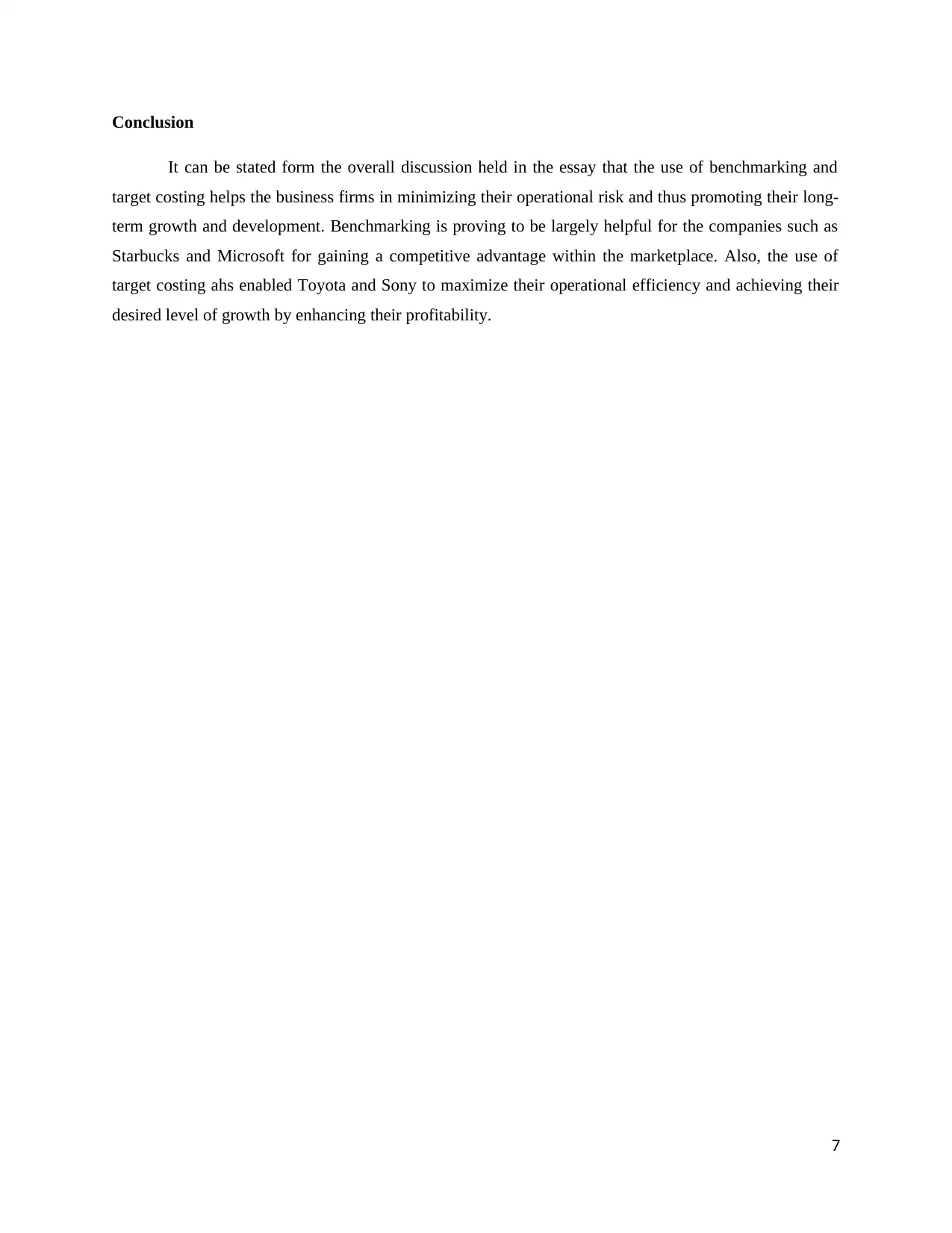
Conclusion
It can be stated form the overall discussion held in the essay that the use of benchmarking and
target costing helps the business firms in minimizing their operational risk and thus promoting their long-
term growth and development. Benchmarking is proving to be largely helpful for the companies such as
Starbucks and Microsoft for gaining a competitive advantage within the marketplace. Also, the use of
target costing ahs enabled Toyota and Sony to maximize their operational efficiency and achieving their
desired level of growth by enhancing their profitability.
7
It can be stated form the overall discussion held in the essay that the use of benchmarking and
target costing helps the business firms in minimizing their operational risk and thus promoting their long-
term growth and development. Benchmarking is proving to be largely helpful for the companies such as
Starbucks and Microsoft for gaining a competitive advantage within the marketplace. Also, the use of
target costing ahs enabled Toyota and Sony to maximize their operational efficiency and achieving their
desired level of growth by enhancing their profitability.
7
Paraphrase This Document
Need a fresh take? Get an instant paraphrase of this document with our AI Paraphraser
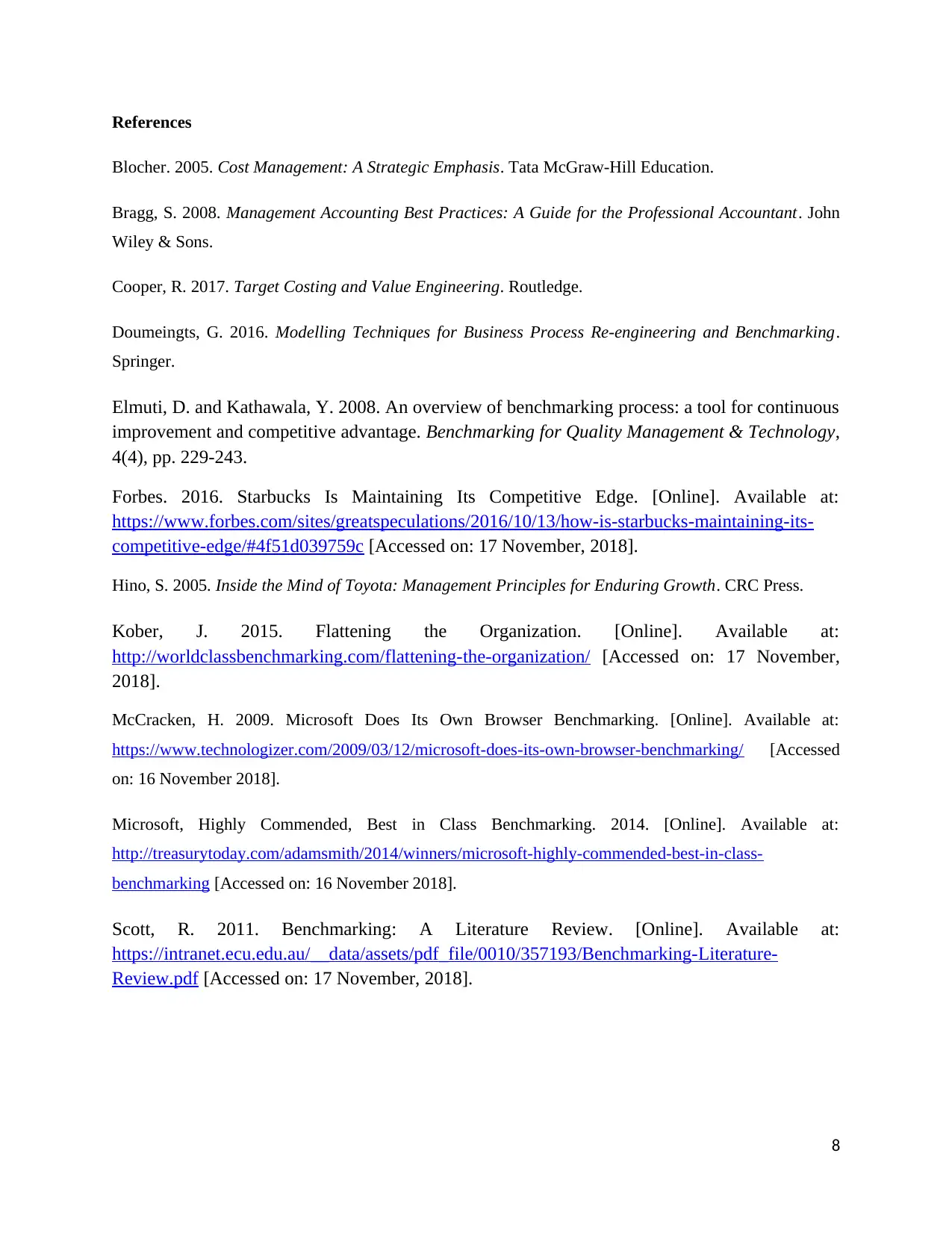
References
Blocher. 2005. Cost Management: A Strategic Emphasis. Tata McGraw-Hill Education.
Bragg, S. 2008. Management Accounting Best Practices: A Guide for the Professional Accountant. John
Wiley & Sons.
Cooper, R. 2017. Target Costing and Value Engineering. Routledge.
Doumeingts, G. 2016. Modelling Techniques for Business Process Re-engineering and Benchmarking.
Springer.
Elmuti, D. and Kathawala, Y. 2008. An overview of benchmarking process: a tool for continuous
improvement and competitive advantage. Benchmarking for Quality Management & Technology,
4(4), pp. 229-243.
Forbes. 2016. Starbucks Is Maintaining Its Competitive Edge. [Online]. Available at:
https://www.forbes.com/sites/greatspeculations/2016/10/13/how-is-starbucks-maintaining-its-
competitive-edge/#4f51d039759c [Accessed on: 17 November, 2018].
Hino, S. 2005. Inside the Mind of Toyota: Management Principles for Enduring Growth. CRC Press.
Kober, J. 2015. Flattening the Organization. [Online]. Available at:
http://worldclassbenchmarking.com/flattening-the-organization/ [Accessed on: 17 November,
2018].
McCracken, H. 2009. Microsoft Does Its Own Browser Benchmarking. [Online]. Available at:
https://www.technologizer.com/2009/03/12/microsoft-does-its-own-browser-benchmarking/ [Accessed
on: 16 November 2018].
Microsoft, Highly Commended, Best in Class Benchmarking. 2014. [Online]. Available at:
http://treasurytoday.com/adamsmith/2014/winners/microsoft-highly-commended-best-in-class-
benchmarking [Accessed on: 16 November 2018].
Scott, R. 2011. Benchmarking: A Literature Review. [Online]. Available at:
https://intranet.ecu.edu.au/__data/assets/pdf_file/0010/357193/Benchmarking-Literature-
Review.pdf [Accessed on: 17 November, 2018].
8
Blocher. 2005. Cost Management: A Strategic Emphasis. Tata McGraw-Hill Education.
Bragg, S. 2008. Management Accounting Best Practices: A Guide for the Professional Accountant. John
Wiley & Sons.
Cooper, R. 2017. Target Costing and Value Engineering. Routledge.
Doumeingts, G. 2016. Modelling Techniques for Business Process Re-engineering and Benchmarking.
Springer.
Elmuti, D. and Kathawala, Y. 2008. An overview of benchmarking process: a tool for continuous
improvement and competitive advantage. Benchmarking for Quality Management & Technology,
4(4), pp. 229-243.
Forbes. 2016. Starbucks Is Maintaining Its Competitive Edge. [Online]. Available at:
https://www.forbes.com/sites/greatspeculations/2016/10/13/how-is-starbucks-maintaining-its-
competitive-edge/#4f51d039759c [Accessed on: 17 November, 2018].
Hino, S. 2005. Inside the Mind of Toyota: Management Principles for Enduring Growth. CRC Press.
Kober, J. 2015. Flattening the Organization. [Online]. Available at:
http://worldclassbenchmarking.com/flattening-the-organization/ [Accessed on: 17 November,
2018].
McCracken, H. 2009. Microsoft Does Its Own Browser Benchmarking. [Online]. Available at:
https://www.technologizer.com/2009/03/12/microsoft-does-its-own-browser-benchmarking/ [Accessed
on: 16 November 2018].
Microsoft, Highly Commended, Best in Class Benchmarking. 2014. [Online]. Available at:
http://treasurytoday.com/adamsmith/2014/winners/microsoft-highly-commended-best-in-class-
benchmarking [Accessed on: 16 November 2018].
Scott, R. 2011. Benchmarking: A Literature Review. [Online]. Available at:
https://intranet.ecu.edu.au/__data/assets/pdf_file/0010/357193/Benchmarking-Literature-
Review.pdf [Accessed on: 17 November, 2018].
8

9
⊘ This is a preview!⊘
Do you want full access?
Subscribe today to unlock all pages.

Trusted by 1+ million students worldwide
1 out of 9
Related Documents
Your All-in-One AI-Powered Toolkit for Academic Success.
+13062052269
info@desklib.com
Available 24*7 on WhatsApp / Email
![[object Object]](/_next/static/media/star-bottom.7253800d.svg)
Unlock your academic potential
Copyright © 2020–2025 A2Z Services. All Rights Reserved. Developed and managed by ZUCOL.




